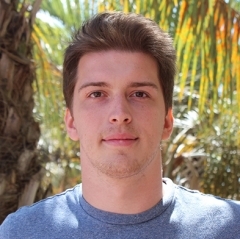Abstract
The desirable physiochemical properties and functions of membrane proteins (such as catalysis, biosensing, and ion transport) have generated interest as guest moieties in synthetic media for technological applications. Specifically, I have used a self-assembled mesostructured silica material host system to functionalize the light activated proton-pump proteorhodopsin outside of its native cell membrane. Incorporated into a device, this protein has applications as a sustainable bio-based alternative for solar-to-electrochemical energy conversion. Traditionally, the inclusion of membrane proteins into non-native inorganic materials has been challenging, in part because the surfactants, polymers, organic solvents, and synthesis conditions used to create well-ordered mesostructures often cause the protein to denature, whereas the biocompatible surfactants that are capable of stabilizing membrane proteins often do not produce the well-ordered mesostructures required of devices. Judicious selection and combination of structure-directing and protein-stabilizing short-chain nonionic surfactants and charged phospholipids has allowed us to stabilize membrane proteins in the cylindrical hydrophobic regions of surfactants within silica. Furthermore, using this host film composition we have achieved a record high 44 wt% concentration of functionally active guest membrane proteorhodopsin, critical to proton-pumping power and the viability of macroscopic proton transport in devices.
Techniques were drawn from multiple fields of study to characterize and understand how these non-native host materials self-assemble, and how they impact the photocycle kinetics of hosted proteorhodopsin. These techniques include X-ray diffraction to determine the structure of the silica film, solid-state NMR spectroscopy to understand atomic-scale structure at the surfactant-silica interface, nanofabrication processes to alter substrates and direct self-assembly at the film-substrate interface, cryo-EM microscopy to determine the structure and intermolecular interactions of proteorhodopsin, and time-resolved UV-visible light spectroscopy to quantify changes in the photocycle of proteorhodopsin due to changes in the host material. Critically, these mesostructured protein-surfactant-silica films are well-ordered and display promising protein loading, mechanical and thermal robustness, and protein stabilizing effects necessary to exploit the highly desirable functions of membrane proteins. A novel and interdisciplinary approach to characterization, understanding, and subsequent optimization of proteorhodopsin and mesostructured silica films has allowed me to achieve robust abiotic inorganic-organic host materials with record high concentrations of functionally active guest membrane proteins, a significant step towards the integration of membrane proteins into devices.




